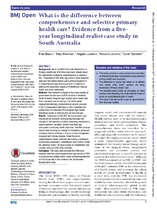| dc.contributor.author | Baum, Fran | |
| dc.contributor.author | Freeman, Toby | |
| dc.contributor.author | Lawless, Angela | |
| dc.contributor.author | Labonte, Ronald | |
| dc.contributor.author | Sanders, David | |
| dc.date.accessioned | 2018-10-31T08:31:58Z | |
| dc.date.available | 2018-10-31T08:31:58Z | |
| dc.date.issued | 2017 | |
| dc.identifier.citation | Baum, F. et al. (2017). What is the difference between comprehensive and selective primary health care? Evidence from a five-year longitudinal realist case study in South Australia. BMJ Open, 7: e015271. | en_US |
| dc.identifier.issn | 2044-6055 | |
| dc.identifier.uri | http://dx.doi.org/10.1136/ bmjopen-2016-015271 | |
| dc.identifier.uri | http://hdl.handle.net/10566/4168 | |
| dc.description.abstract | BACKGROUND Since the WHO’s Alma Ata Declaration on
Primary Health Care (PHC) there has been debate about
the advisability of adopting comprehensive or selective
PHC. Proponents of the latter argue that a more selective
approach will enable interim gains while proponents of
a comprehensive approach argue that it is needed to
address the underlying causes of ill health and improve
health outcomes sustainably.
METHODS This research is based on four case studies of
government-funded and run PHC services in Adelaide,
South Australia. Program logic models were constructed
from interviews and workshops. The initial model
represented relatively comprehensive service provision
in 2010. Subsequent interviews in 2013 permitted the
construction of a selective PHC program logic model
following a series of restructuring service changes.
RESULTSComparison of the PHC service program logic
models before and after restructuring illustrates the
changes to the operating context, underlying mechanisms,
service qualities, activities, activity outcomes and
anticipated community health outcomes. The PHC services
moved from focusing on a range of community, group and
individual clinical activities to a focus on the management
of people with chronic disease. Under the more
comprehensive model, activities were along a continuum
of promotive, preventive, rehabilitative and curative. Under
the selective model, the focus moved to rehabilitative and
curative with very little other activities.
CONCLUSION The study demonstrates the difference
between selective and comprehensive approaches to PHC
in a rich country setting and is useful in informing debates
on PHC especially in the context of the Sustainable
Development Goals. | en_US |
| dc.language.iso | en | en_US |
| dc.publisher | BMJ Publishing Group | en_US |
| dc.subject | WHO | en_US |
| dc.subject | Primary Health Care (PHC) | en_US |
| dc.subject | Comprehensive | en_US |
| dc.subject | Selective | en_US |
| dc.subject | Australia | en_US |
| dc.title | What is the difference between comprehensive and selective primary health care? Evidence from a five-year longitudinal realist case study in South Australia | en_US |
| dc.type | Article | en_US |
| dc.privacy.showsubmitter | FALSE | |
| dc.status.ispeerreviewed | TRUE | |

